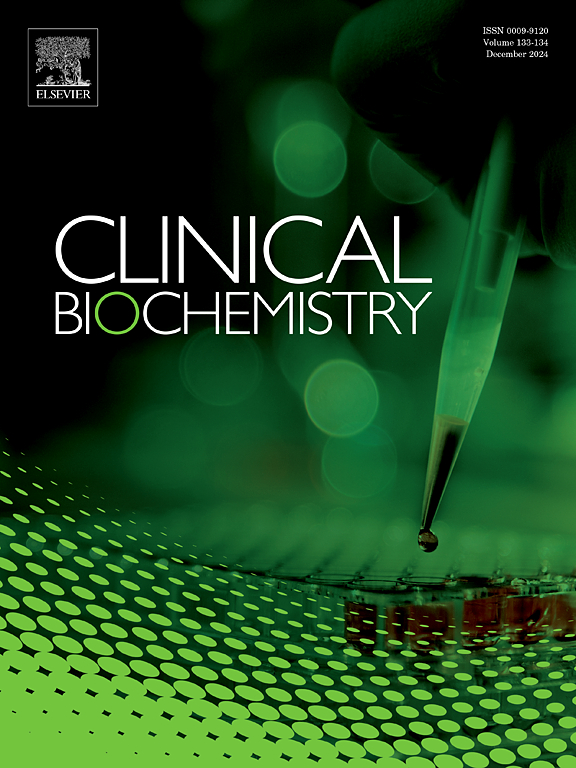CA19-9, CEA and PIVKA-Ⅱ as a novel panel of serum markers for diagnosis of pancreatic cancer
IF 2.5
3区 医学
Q2 MEDICAL LABORATORY TECHNOLOGY
引用次数: 0
Abstract
Aim
This retrospective study was aimed to evaluate the diagnostic value of a combination of carbohydrate antigen 19–9 (CA19-9), carcinoembryonic antigen (CEA) and protein induced by vitamin K absence or antagonist-Ⅱ (PIVKA-II) in pancreatic cancer.
Methods
Clinical data were collected from 111 pancreatic cancer patients and 158 patients with benign pancreatic diseases (BPD). Serum CA19-9, CEA and PIVKA-II were subjected to receiver operating characteristic curve (ROC) analysis alone and in combination for the diagnosis of pancreatic cancer.
Results
Serum CA19-9, CEA, and PIVKA-II were higher in pancreatic cancer patients than in BPD patients (P < 0.001). ROC analysis indicated that the cutoff values were 99.390 for CA19-9, 3.065 for CEA, and 42.965 for PIVKA-II, at which the positive rate in pancreatic cancer was 78.38 % for CA19-9, 43.24 % for CEA and 48.65 % for PIVKA-Ⅱ. When serum CA19-9, CEA, and PIVKA-II were used alone, the areas under the curves (AUC), sensitivity and specificity were 0.821, 68.47 % and 89.24 % for CA19-9, 0.763, 61.26 % and 85.44 % for CEA, and 0.681, 45.95 % and 87.34 % for PIVKA-II. When serum CA19-9, CEA, and PIVKA-II were used in combination, the positivity rate was 94.59 % in pancreatic cancer with AUC of 0.903, sensitivity of 81.10 % and specificity of 88.00 %.
Conclusion
PIVKA-II is a potential serum marker of pancreatic cancer and the combination of CA19-9, CEA, and PIVKA-II is a novel panel of serum markers with promising diagnostic value for pancreatic cancer.

CA19-9、CEA和PIVKA-Ⅱ作为诊断胰腺癌的一组新的血清标志物
目的回顾性研究碳水化合物抗原19-9 (CA19-9)、癌胚抗原(CEA)和维生素K缺失或拮抗剂Ⅱ诱导的蛋白(PIVKA-II)联合检测对胰腺癌的诊断价值。方法收集111例胰腺癌和158例良性胰腺疾病(BPD)患者的临床资料。血清CA19-9、CEA、PIVKA-II分别单独或联合进行受试者工作特征曲线(ROC)分析,用于胰腺癌的诊断。结果胰腺癌患者血清CA19-9、CEA、PIVKA-II水平高于BPD患者(P <;0.001)。ROC分析显示,CA19-9、CEA和PIVKA- ii的截止值分别为99.390、3.065和42.965,其中CA19-9、CEA和PIVKA-Ⅱ在胰腺癌中的阳性率分别为78.38%、43.24%和48.65%。单独使用血清CA19-9、CEA和PIVKA-II时,CA19-9的曲线下面积(AUC)、敏感性和特异性分别为0.821、68.47%和89.24%,CEA的敏感性和特异性分别为0.763、61.26%和85.44%,PIVKA-II的敏感性和特异性分别为0.681、45.95%和87.34%。当血清CA19-9、CEA和PIVKA-II联合使用时,胰腺癌的阳性率为94.59%,AUC为0.903,敏感性为81.10%,特异性为88.00%。结论PIVKA-II是一种潜在的胰腺癌血清标志物,CA19-9、CEA、PIVKA-II联合检测是一种新型的胰腺癌血清标志物,具有良好的诊断价值。
本文章由计算机程序翻译,如有差异,请以英文原文为准。
求助全文
约1分钟内获得全文
求助全文
来源期刊

Clinical biochemistry
医学-医学实验技术
CiteScore
5.10
自引率
0.00%
发文量
151
审稿时长
25 days
期刊介绍:
Clinical Biochemistry publishes articles relating to clinical chemistry, molecular biology and genetics, therapeutic drug monitoring and toxicology, laboratory immunology and laboratory medicine in general, with the focus on analytical and clinical investigation of laboratory tests in humans used for diagnosis, prognosis, treatment and therapy, and monitoring of disease.
 求助内容:
求助内容: 应助结果提醒方式:
应助结果提醒方式:


